How to Build a Product Roadmap for a Seamless App Development Process

Have you ever tried booking a plane ticket without an itinerary?
While exploring a new city overseas without booking a hotel seems exciting, planning is never an afterthought when building your business. It’s indispensable.
The same principle applies when developing an app. A plan, direction, and product strategy co-exist for a seamless collaboration across teams and clients. With a structured product roadmap, people involved in a sea of tasks and requirements can keep tabs on the priorities.
According to Gartner’s survey, 78% of product managers who focused on improving cooperation between internal stakeholders had low product failure rates. Additionally, 39% believed building a roadmap was a major responsibility.
Want to make sure your app is launched according to plan? In this article, let’s unpack how to build a product roadmap for your app.
Whether you’re still developing your app idea or already funded and ready to take the shots for app development, make sure the roadmap spearheaded by your product manager will take you to the next level.
But before that, let’s first define what a product roadmap is.
What is a product roadmap?
A product roadmap is more than just a visual. It’s a strategic compass that guides the journey of a product through time. For product managers and teams, it’s a roadmap to success, outlining goals, features, timelines, and the precise steps needed to reach those milestones.
This strategic tool articulates the essence of “why” and “what” propels a product team forward. It encapsulates the product’s vision and direction in a visually compelling manner, uniting internal teams and external partners like key stakeholders behind a shared mission of achieving key goals and milestones.
A product roadmap scope includes the entire app lifecycle, and the product manager is often responsible for creating it.
Now, let’s move on to the meatiest part: creating a product roadmap for product design and development.
How do you build a product roadmap? 6 steps to ensure team efficiency
- Define your product vision and strategy
- Gather ideas and prioritize features and requirements
- Build the roadmap foundation
- Tailor roadmaps for different audiences
- Choose the road mapping tool
- Create the product roadmap
Crafting a product roadmap involves essential steps, beginning with crystalizing your product vision and strategy. This pivotal stage lays the groundwork for all future planning and development endeavors, setting the course for app success.
1. Define your product vision and strategy
At the heart of your product lies its core purpose. Start by pinpointing the specific problem your app sets out to solve.
Understanding the “why” guides your app development team and connects your product with broader business objectives, providing direction and motivation.
In this step, key components are present to ensure clarity on your narratives and presentation of the product roadmap itself.
Let me unpack some of them below.
- 📣 User research. Conduct comprehensive market research to identify your target audience’s identities, behaviors, and pain points. Capitalizing on user interviews, surveys, and persona development offers profound insights into understanding their world and pain points.
- 📣 Customer feedback. Seek feedback from potential users to ensure your product vision resonates with their needs. By aligning with user expectations, you can craft a solution that genuinely addresses real-world challenges, making a meaningful impact.
- 📣 Unique selling proposition. Define what separates your product from the competitors and why users would choose it over competitors. A compelling value proposition is the key to capturing and retaining a loyal user base.
- 📣 Strategic objectives. Set clear, specific, and measurable goals aligning with your business strategy. Whether expanding market share, enhancing user engagement, or hitting revenue milestones, these goals should be attainable within a defined timeframe.
- 📣 Key initiatives. Identify pivotal projects that advance your strategic goals, such as introducing new features, enhancing existing app functionalities, or launching impactful marketing campaigns to drive installs. Prioritize these initiatives based on their potential influence and feasibility to steer your app toward success.
Sometimes, the why of your product is right in front of you. Let me tell you the unique story of Matthew Pacella.
Matthew Pacella, a lawyer and avid traveler, grew weary of outdated trip-planning methods. He felt bogged down by the inefficiency of using multiple apps like Google Sheets.
This led him to find a more streamlined solution, yearning for a modern approach to organizing his adventures without the hassle of switching between various third-party tools.
Driven by a desire for simplicity, Matthew sought a way to harmonize his travel plans effectively. Together with our team of app developers at Appetiser, he brought his vision to life: Vaiva. The app offers a user-friendly platform that redefined trip planning for him and fellow travelers.
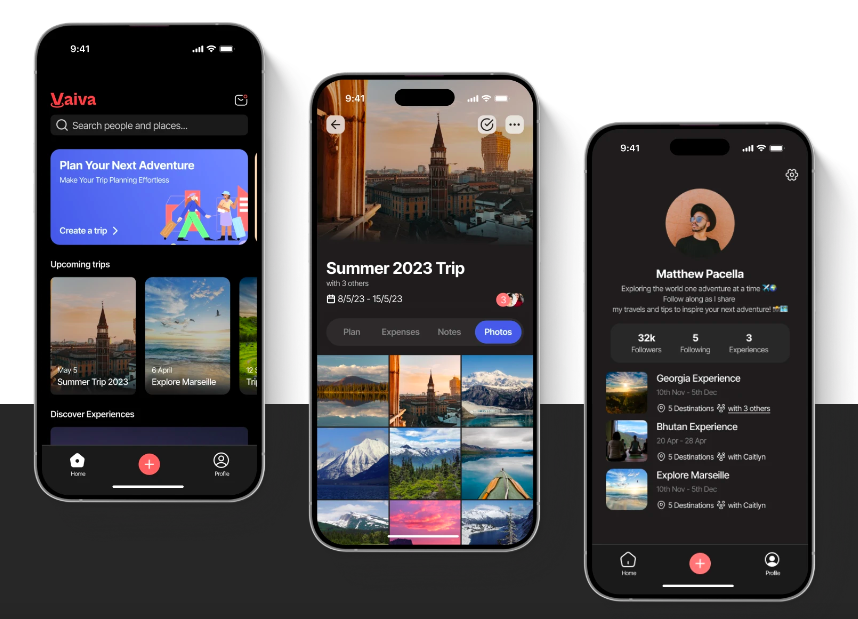
💡 Read the case study of Vaiva and be inspired by how Mathew and Appetiser worked together to birth his vision.
2. Gather ideas and prioritize features and requirements
It’s a skill to gather ideas and arrange them according to priorities, including the features and requirements, without getting bogged down in an ocean of tasks and projects. But I’m sure product managers excel in this area.
Product managers use these techniques to gather ideas in a more holistic approach.
We can fork this step in two ways: brainstorming and prioritizing features and requirements.
Here’s what I’ve gathered so far from how the brightest product managers on our team flesh out ideas internally and externally in product roadmap planning:
Use of brainstorming sessions
- ✅ Inspiring ideation sessions or idea dumping. Inspire your team by hosting collaborative brainstorming sessions with diverse talents like the sales team, app developers, app designers, and product managers. Embrace tools such as mind maps, like MindMeister, and digital whiteboards, like Miro and Figma, to fuel creativity and spark innovative ideas.
- ✅ Using innovative idea management platforms. Make idea generation collaborative through modern platforms seamlessly integrated with tools like Microsoft Teams, Google Workspace, and Figma. For those seeking different functionalities or pricing, exploring Microsoft 365 alternatives can also provide suitable options. Capture, nurture, and expand upon ideas efficiently, empowering clients to contribute and evolve concepts.
- ✅ Tapping customer-centric support insights. Harness the frontline expertise of the customer support team to glean real-world feedback from users. Uncover common issues and user requests, guiding product enhancements and app performance.
When prioritizing features and requirements, product managers use other tools and techniques to efficiently present all information and narratives clearly.
Let’s unpack each.
Use of prioritization frameworks
MoSCoW Method
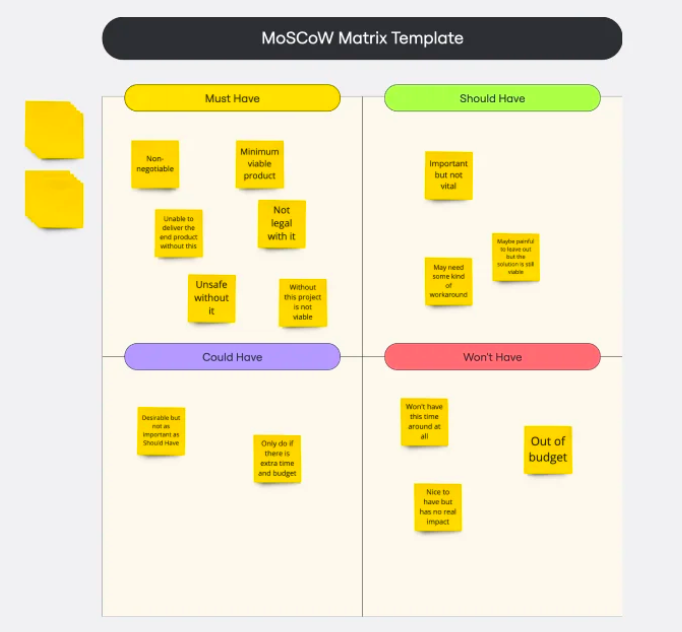
Source: Miro
The MoSCoW method categorizes features into four groups:
- Must-Have (Mo). Essential features critical for the product’s success.
- Should-Have (S). Important features that enhance the product but are not critical.
- Could-Have (Co). Desirable features that can be included if time and resources permit.
- Won’t-Have (W). Features that are not planned for the current scope but may be considered for future iterations.
Product managers categorize features into Must have, Should have, Could have, and Won’t have. This helps in distinguishing essential features from those that are nice-to-have.
Impact vs. Effort Matrix
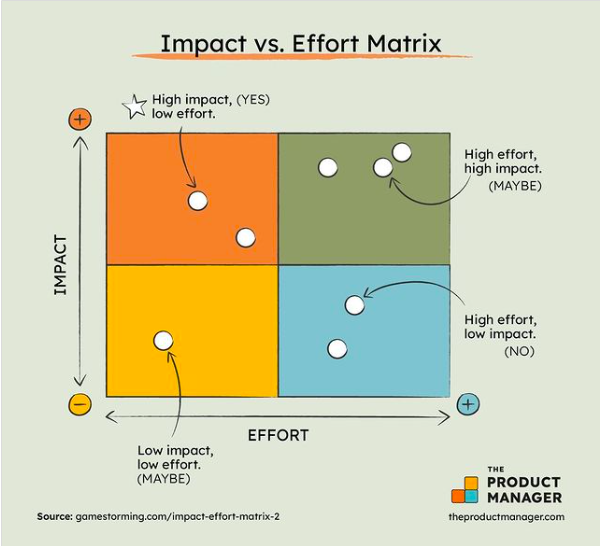
Source: The Product Manager Instagram
The Impact vs. Effort Matrix is a 2×2 grid that plots potential features or tasks based on two dimensions:
- Impact. The potential value or benefit a feature will bring to users or the business.
- Effort. The amount of work, time, and resources required to implement the feature.
The matrix is divided into four quadrants:
- Quick Wins. High impact, low effort.
- Major Projects (Big Bets). High impact, high effort.
- Fill-ins. Low impact, low effort.
- Money Pits. Low impact, high effort.
Usually, it’s a good practice to evaluate features based on their potential impact and the effort required to implement them.
Kano Model

Source: Sapio Research
In this framework, you can classify features based on their ability to satisfy users. Identify basic needs, performance needs, and excitement featuresFor example, you can survey users to understand their expectations and classify features accordingly. Basic features like app stability are essential, while innovative features like augmented reality integration and app gamification can delight users.
Creating a product roadmap can also happen even if you already have a mobile app in the market. Gathering ideas may happen in the middle of the app’s lifecycle.
When your app performance turns sour, a better approach is to find another team to handle the problem. In contrast, when you want to expand new users, you can also tap mobile app developers to increase your sales.
That’s what Youfoodz did.
We rose to the challenge when Youfoodz sought to expand its reach to a broader smartphone user base and solidify its position in Australia. By crafting a dynamic app capable of handling thousands of orders weekly, we laid the foundation for the company’s remarkable journey.
Subsequently, Youfoodz clinched the prestigious title of Australia’s #1 Healthy Food Delivery Service for three consecutive years.

Today, the app drove revenues, which generated $100,000 daily, propelling Youfoodz to sustain growth amidst the competitive landscape of healthy food delivery services.
![]()
Read the case study of Youfoodz and learn how they achieved incredible milestones with the Appetiser team on their side to support and execute their vision.
3. Build the roadmap foundation
Just as a skilled architect meticulously plans every detail to construct a sturdy building, a product manager strategically lays the foundation of a product roadmap.
This roadmap acts as the blueprint for success, guiding the journey towards creating a product that is not just functional but visionary, comprehensive, and product market fit.
So, how does a product manager build a roadmap foundation, paving the way for product excellence?
1. Define high-level product themes or tracks
Product themes are high-level strategic goals that guide the overall direction of the product. Themes help organize and prioritize features based on the customer needs or problems they address.
Common themes include user experience, core functionality, performance, security, and app monetization.
2. Group features into epics and user stories
Epics are large bodies of work that can be broken down into smaller tasks or user stories. Meanwhile, user stories are specific functionalities or features that deliver value to the user.

Source: Pramod Hanumappa YouTube
Grouping features into epics and user stories helps manage and track the development process more effectively.
Here’s a simplified explanation of how epics and user stories work together.
3. Map out a visual timeline with target milestones or releases
Creating a visual timeline helps plan and communicate the product or app development process.
This timeline should include key milestones and release dates, clearly showing when you will deliver different features and updates.
Example:
- Q1 Milestone: Launch new onboarding flow.
- Q2 Milestone: Release mobile app version 1.0.
- Q3 Milestone: Implement push notifications.
- Q4 Milestone: Introduce in-app purchase options.
I found this video from Atlassian that shows an overview of how to map out these timelines and releases.
4. Determine the roadmap’s scope and timeframe
The scope and timeframe of the roadmap should be realistic and aligned with your strategic goals. Typically, product roadmaps span 4 to 12 months, providing a balance between short-term and long-term planning.
Here’s an example:
- Scope: Focus on enhancing user engagement and expanding mobile capabilities.
- Timeframe: Plan for the next 6 months, with quarterly reviews to adjust based on progress and new insights
📣 Fun fact: Did you know that our proprietary framework Appetiser Baseplate™ cuts iOS development by 50%? This allows our clients to launch faster than their competitors.
Now, let’s move on to the next section, where the process involves internal teams and external partners.
4. Tailor roadmaps for different audiences
Crafting a product roadmap for app development requires a thoughtful approach to cater to diverse audiences effectively.
By tailoring the roadmap to different audiences, you ensure each team receives the information most pertinent to their roles and responsibilities.
Here’s how product managers do it for maximum impact and alignment internally and across all external partners:
1. Create a strategic, high-level roadmap for executives and stakeholders
Executives and stakeholders need a high-level overview that aligns with the company’s strategic goals and key performance indicators (KPIs). This roadmap should focus on major initiatives and themes rather than granular details.
In this method, the devil is in the details, and it’s best to keep the information as an overview to avoid creating confusion among the high-level executives.Example:
Theme: Improve user engagement initiative
- Launch a new user onboarding experience Initiative
- Implement gamification features Initiative
- Enhance the push notification system
2. Build a detailed roadmap with specifics for development teams
Development teams require a detailed roadmap with specific tasks, timelines, and dependencies. This roadmap should be granular and focused on the execution of the product plan.
For example, assuming the team uses Agile methodology, Sprint 1 will look like this to guide the app design and development teams.
Feature 1: User onboarding flow
- Task 1: Design wireframes
- Task 2: Develop front-end components
- Task 3: Integrate with the backend
Feature 2: Push notifications
- Task 1: Set up notification service
- Task 2: Create notification templates
- Task 3: Test notification delivery
3. Prepare a public, customer-facing version highlighting key new features
A customer-facing roadmap should highlight key new features and upcoming improvements to engage and inform customers. This roadmap should be less detailed and more focused on the benefits to the users.
Here’s a theoretical example to give you a visual overview of how this can be done:
| Now | Next | Later | |
|---|---|---|---|
| Feature | Slack integration | Enhanced security features | AI-powered recommendations |
| Description | Sync messages and threads between our app | Implement advanced security protocols to protect user data | Explore the possibility of using AI to provide personalized content recommendations |
This structured format simplifies information, offering a clear view of current, upcoming, and future developments.
By refraining from overpromising specific timelines or features, you maintain transparency and manage expectations effectively, preventing customer disappointment in case of changes.
Moreover, fostering a dialogue with customers by encouraging feedback transforms the roadmap into a collaborative tool, enabling valuable insights that refine and enhance future strategies.
Customizing your product roadmap for diverse audiences guarantees that each team receives tailored information and enhances your communication among the people involved in the project.
This tailored approach sets clear expectations and fosters a culture of feedback, allowing for valuable insights that drive continuous improvement and success.
5. Choose the right road mapping tool
Creating a product roadmap for app development hinges on selecting the ideal roadmapping tool to ensure clarity, effectiveness, and actionability.
So, what do you look for in a product roadmap tool?
Here are key features to watch out for:
- ✅ Visualization. Opt for tools with customizable visualizations like Gantt charts for clear communication.
- ✅ Collaboration. Choose platforms enabling real-time collaboration among team members for seamless updates.
- ✅ Integrations. Seek tools that integrate smoothly with other project management systems to streamline workflows.
Here’s a breakdown of three popular road mapping tools and key features that product managers often use, along with essential tips for formatting and organizing your roadmap effectively:
ClickUp
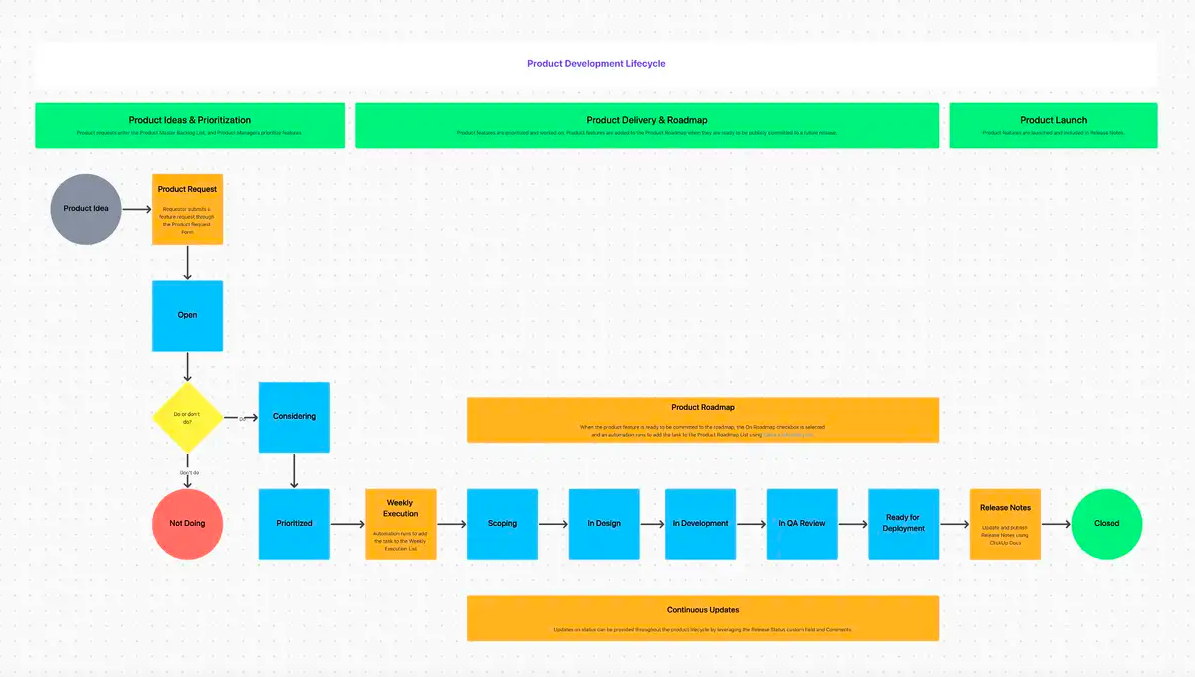
Source: ClickUp
A versatile project management tool offering robust roadmapping capabilities for visualizing the product development lifecycle and tracking progress.
Use ClickUp’s Product Roadmap Template to map out each step of the product development cycle, from ideation to launch. This template helps in visualizing the product’s future and aligning the team around common goals.
Trello

Source: Trello
Trello is a user-friendly tool for organizing tasks using boards, lists, and cards. It’s particularly useful for visualizing workflows and managing projects.
Create a Trello board dedicated to your product roadmap. Organize lists such as “Planned,” “In Progress,” and “Completed” to track the status of various features or initiatives. Use cards to detail each feature, including descriptions, benefits, and relevant links.
ProductPlan
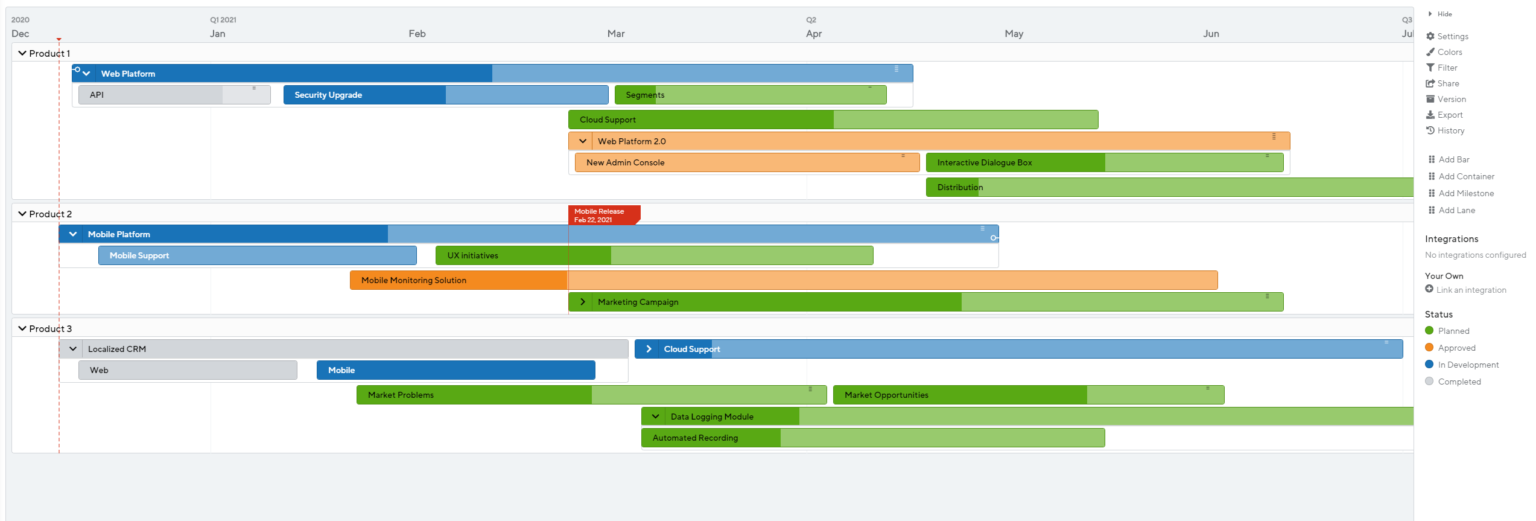
Source: ProductPlan
ProductPlan is a dedicated roadmapping tool designed to help product managers create, manage, and share product roadmaps. It offers features like portfolio roadmaps, custom views, product roadmap examples, templates, and integrations with other tools.
Use ProductPlan to create a high-level strategic roadmap that aligns with your company’s goals. This tool allows you to roll multiple roadmaps into a single view, making it easier to manage complex product portfolios.
There are hundreds of tools out there, and it’s a big win to explore them and see which one best fits your workflow.
When building a product roadmap, our product managers have a few tips like:
- ✅ Use clear visuals with color coding to highlight key initiatives.
- ✅ Keep executive presentations high-level and focused on strategic goals.
- ✅ Provide detailed views for development teams with specific tasks and timelines.
- ✅ Regularly update the roadmap to maintain alignment and clarity among internal and external teams and partners.
By selecting the right tool and implementing these formatting and organizational tips, you can communicate the app’s direction and strategy without overwhelming the audience.
6. Create the roadmap
Once you have chosen your project management software or product roadmap template, it’s time to put all the abstract ideas into action: Create the actual roadmap.
Enjoy the process of putting all the ideas, features, and priorities, and be sure to accommodate changes and updates as needed.
I found this video on YouTube by Jeff Lash, a product management expert who shared his best practices at a conference in Lisbon. This could be supplemental information as well as you build your product roadmap for teams, high-profile executives, and app users.
Plan your roadmap with app development experts
Building a product roadmap is an essential step in the app development process. It helps define your vision and strategy and allows you to prioritize features and requirements.
With the right foundation and tailored roadmaps for different audiences, your roadmap can guide you to bring your app idea to life successfully.
With the plethora of road mapping tools available, finding one that suits your specific needs is easy.
Remember, a well-constructed product roadmap can make all the difference in creating an app that will be the darling of your users.
With this guide, you now have all the key elements needed to build an effective product roadmap. Are you ready to take the next step on your app journey?
Book a call with us today and share your app idea or app enhancement you want to achieve with our experienced team of product strategists.
Let us help bring your vision to life and create an app that will stand out in the ever-growing app market. The possibilities are endless, so why wait?

Maria Krisette Lim is a Content Marketing Specialist with 14 years of experience producing web and print ad content. Krisette has a BSBA degree, major in Business Management and Entrepreneurship. When she’s not tinkering with words and punctuation, she’s either curled up with a book while sipping hot tea, playing with her toddler, or tinkering with website builders.


